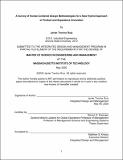| dc.contributor.author | Trevino Ruiz, Javier. | en_US |
| dc.contributor.other | Massachusetts Institute of Technology. Integrated Design and Management Program. | en_US |
| dc.contributor.other | Massachusetts Institute of Technology. Engineering and Management Program. | en_US |
| dc.contributor.other | System Design and Management Program. | en_US |
| dc.date.accessioned | 2021-10-08T16:59:55Z | |
| dc.date.available | 2021-10-08T16:59:55Z | |
| dc.date.copyright | 2020 | en_US |
| dc.date.issued | 2020 | en_US |
| dc.identifier.uri | https://hdl.handle.net/1721.1/132870 | |
| dc.description | Thesis: S.M. in Engineering and Management, Massachusetts Institute of Technology, System Design and Management Program, May, 2020 | en_US |
| dc.description | Cataloged from the official version of thesis. | en_US |
| dc.description | Includes bibliographical references (pages 68-69). | en_US |
| dc.description.abstract | Today, design is not just considered to be creating something beautiful but is understood and adopted as a problem-solving tool for creative idea generation for disruptive and innovative products, services, and experiences. There has been a boom in design methodologies with a big marketing campaign behind tools and methodologies that have become buzz words. The diversity of the design methods in use raises the questions of which is the best framework, and which is the best method for product design, user experience, or service design. Is there a universal method that can be used for all types of projects, or does it depend on the goals to be achieved? This thesis analyzes the strengths and weaknesses of thirty methodologies according to five simplified categories of the design process: inspire, ideate, experiment, test, and validate. Using this analysis, I chose and combined the strongest design methodologies in each stage to create a new hybrid methodology based on the strengths of each. The new proposed hybrid methodology includes steps from ten popular approaches to design: Jobs-To-Be-Done, Product Design & Development, Experience Design, UX Strategy, Design Thinking, The Lean Product Playbook, Value Proposition Design, and The Circular Guide. The combination of these Human-centered methodologies includes qualitative and quantitative research, creative thinking, innovation strategy, concept building, testing, and business validation. The main purpose of this research was to create a hybrid methodology to be used in different types of projects from product design, service design, experience design; but it is flexible enough to also be used in projects like healthcare, public policy, energy, physical spaces, technology (e.g., IoT), and Fintech. | en_US |
| dc.description.statementofresponsibility | by Javier Trevino Ruiz. | en_US |
| dc.format.extent | 73 pages | en_US |
| dc.language.iso | eng | en_US |
| dc.publisher | Massachusetts Institute of Technology | en_US |
| dc.rights | MIT theses may be protected by copyright. Please reuse MIT thesis content according to the MIT Libraries Permissions Policy, which is available through the URL provided. | en_US |
| dc.rights.uri | http://dspace.mit.edu/handle/1721.1/7582 | en_US |
| dc.subject | Integrated Design and Management Program. | en_US |
| dc.subject | Engineering and Management Program. | en_US |
| dc.subject | System Design and Management Program. | en_US |
| dc.title | A survey of human-centered design methodologies for a new hybrid approach in product and experience innovation | en_US |
| dc.type | Thesis | en_US |
| dc.description.degree | S.M. in Engineering and Management | en_US |
| dc.contributor.department | Massachusetts Institute of Technology. Integrated Design and Management Program | en_US |
| dc.contributor.department | Massachusetts Institute of Technology. Engineering and Management Program | en_US |
| dc.identifier.oclc | 1263350956 | en_US |
| dc.description.collection | S.M.inEngineeringandManagement Massachusetts Institute of Technology, System Design and Management Program | en_US |
| dspace.imported | 2021-10-08T16:59:55Z | en_US |
| mit.thesis.degree | Master | en_US |
| mit.thesis.department | SysDes | en_US |
